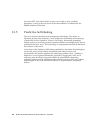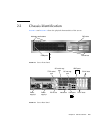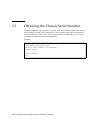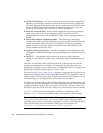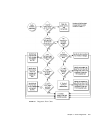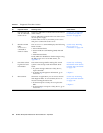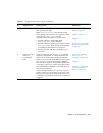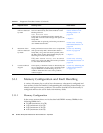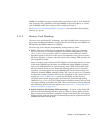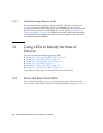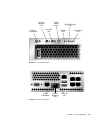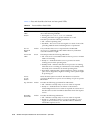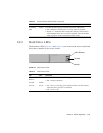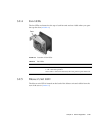
3-6 SPARC Enterprise T2000 Server Service Manual • April 2007
3.1.1 Memory Configuration and Fault Handling
A variety of features play a role in how the memory subsystem is configured and
how memory faults are handled. Understanding the underlying features helps you
identify and repair memory problems. This section describes how the memory is
configured and how the server deals with memory faults.
3.1.1.1 Memory Configuration
In the server memory there are 16 slots that hold DDR-2 memory DIMMs in the
following DIMM sizes:
■ 512 MB (maximum of 8 GB)
■ 1 GB (maximum of 16 GB)
■ 2 GB (maximum of 32 GB)
■ 4 GB (maximum of 64 GB)
7.
Determine if the
fault was detected
by PSH.
If the fault message displays the following text, the
fault was detected by the Solaris Predictive Self-
Healing software:
Host detected fault
If the fault is a PSH detected fault, identify the
faulty FRU from the fault message and replace the
faulty FRU.
After the FRU is replaced, perform the procedure to
clear PSH detected faults.
Section 3.5, “Using the
Solaris Predictive Self-
Healing Feature” on
page 3-40
Chapter 5
Section 3.5.2, “Clearing
PSH Detected Faults” on
page 3-44
8.
Determine if the
fault was detected
by POST.
POST performs basic tests of the server components
and reports faulty FRUs. When POST detects a
faulty FRU, it logs the fault and if possible, takes
the FRU offline. POST detected FRUs display the
following text in the fault message:
FRU_name deemed faulty and disabled
In this case, replace the FRU and run the procedure
to clear POST detected faults.
Section 3.4, “Running
POST” on page 3-26
Chapter 5
Section 3.4.6, “Clearing
POST Detected Faults” on
page 3-39
9.
Contact technical
support.
The majority of hardware faults are detected by the
server’s diagnostics. In rare cases a problem might
require additional troubleshooting. If you are
unable to determine the cause of the problem,
contact support.
Section 2.3, “Obtaining the
Chassis Serial Number”
on page 2-10
TABLE 3-1 Diagnostic Flowchart Actions (Continued)
Action
No. Diagnostic Action Resulting Action
For more information, see
these sections



